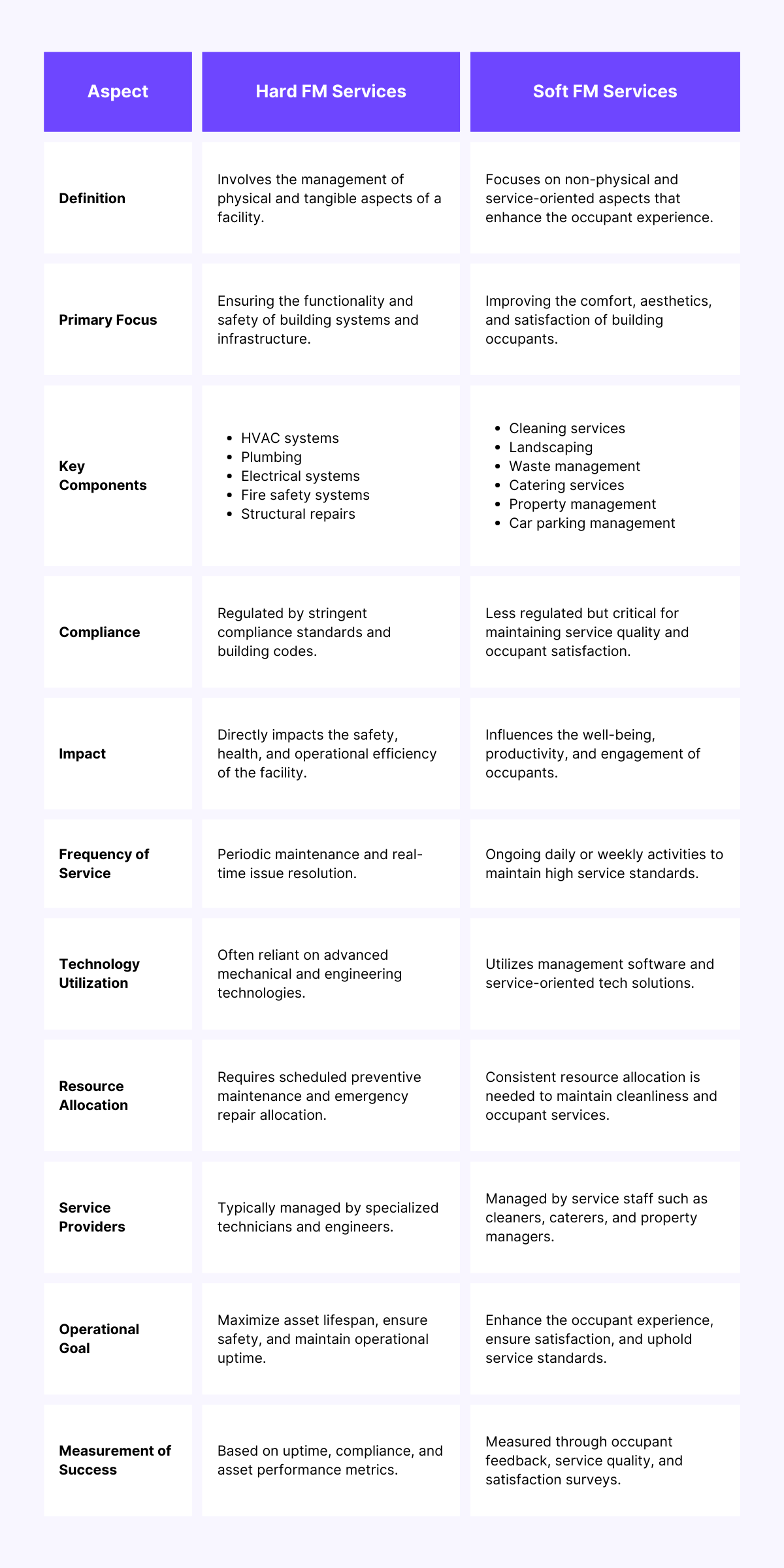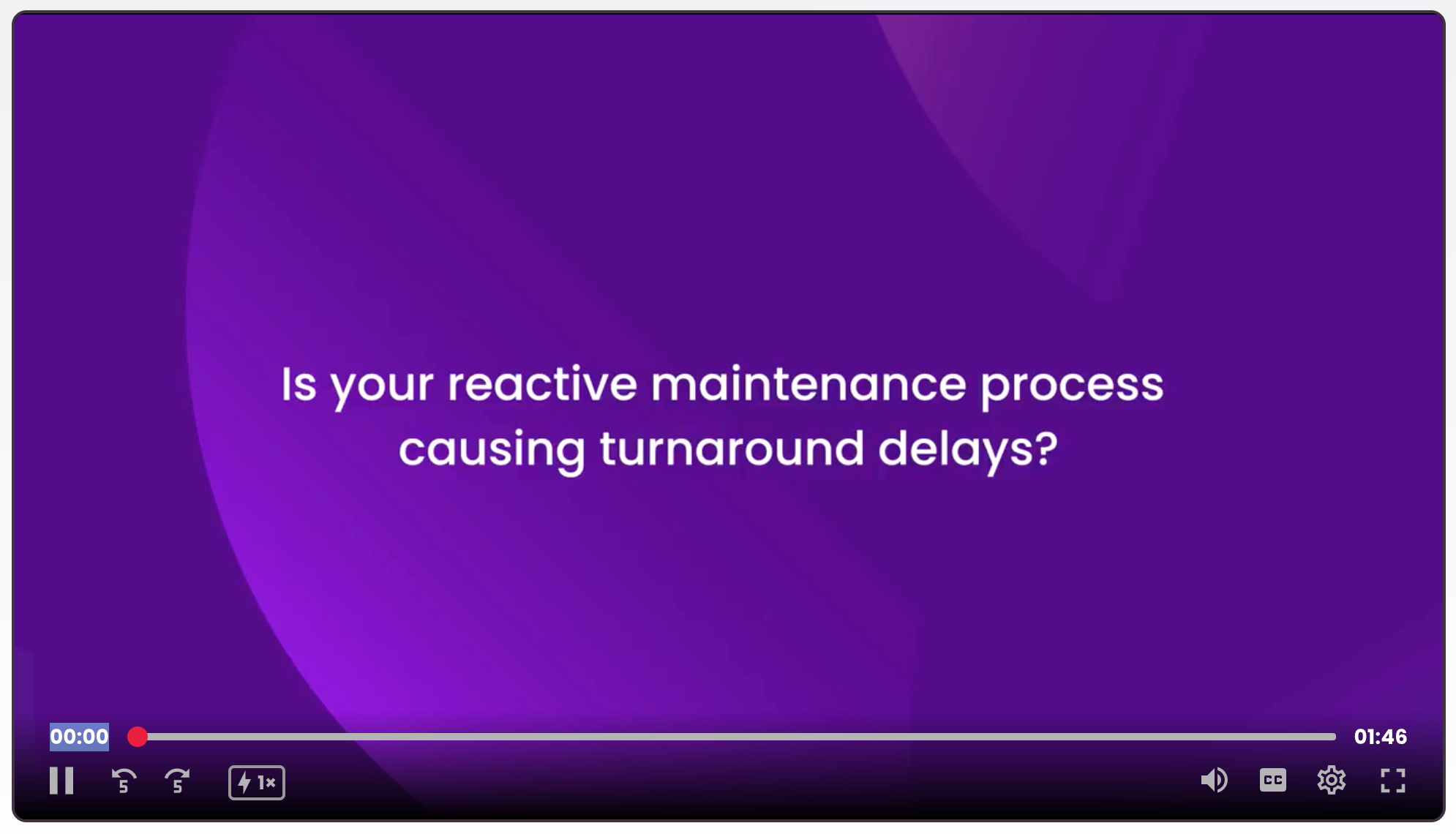How to Achieve Excellence In Soft FM and Hard FM Services
Managing facilities is becoming increasingly complex.
Facility managers often grapple with common challenges such as keeping both hard FM services—like HVAC maintenance and structural repairs—and soft FM services—such as cleaning and workspace management—in sync.
Without a strategic approach, inefficiencies can easily creep in, leading to climbing operational costs and declining occupant satisfaction.
However, legacy CaFM systems fall short when it comes to juggling both hard and soft FM services equally well.
Let's dive into the differences between hard and soft FM services and explore how to streamline and unify your facility management practices, making them both efficient and effective.
Why do these differences and classifications matter?
Under the Workplace (Health, Safety and Welfare) Regulations 1992, property owners are mandated to ensure the daily health, safety, and welfare of a building’s occupants.
Categorizing FM services into hard and soft components allows facility managers and IFMSPs (Integrated Facilities Management Service Providers) to efficiently manage large portfolios of multiple buildings.
Also.. Hard FM, Soft FM... Why can't they just get along?
It's 9 PM on a Friday and you get a frantic call about a burst pipe. Your maintenance crew rushes in, tools blazing, only to slip on a freshly mopped floor.
It's a slapstick comedy of errors, but for FMSPs in the Middle East and the UK, it's no laughing matter.
This disconnect between hard and soft services isn't just inconvenient, it's costing you. Lost productivity, unhappy clients, missed opportunities – all because your systems are stuck in silos.
But what if there was a better way?
What if every service request, every piece of data, every team member was part of a unified, intelligent ecosystem?
The pipe bursts, but this time, the cleaning crew is instantly alerted. The floor is dried, the repair is made safely, and the client is kept in the loop. That's the power of a connected ecosystem, where your helpdesk and CaFM work in perfect harmony.
That's what the rest of the article is about. Keep reading to discover how Facilio can make it happen.

From the table, it is evident that every facility necessitates both hard and soft FM service management, though the extent to which each is required varies. Identifying which service demands greater focus and resource allocation is crucial for optimal facility performance.
What are some hurdles FMs face in delivering exceptional service?
While hard and soft FM services may differ in an array of aspects, the hurdles involved in fulfilling customer expectations and leaving a good impression on the customers and employees alike.
1. Low productivity levels
Facility managers often struggle to achieve high levels of productivity with traditional CMMS systems. These outdated tools lack the real-time visibility needed to proactively make decisions, causing delays and inefficiencies in managing work orders.
The absence of automated and optimized dispatching means that technicians are often not allocated based on their skills, location, or workload. This inefficiency leads to suboptimal resource allocation, resulting in longer wait times and increased costs.
Technicians operating under these legacy systems rarely have instant access to crucial job details, asset histories, and checklists. This lack of immediate information contributes to lower first-time fix rates and extended downtime, negatively impacting service quality.
2. No room for flexibility
The field of FM services is unpredictable and there’s often a cry for change or help in terms of:
- Revolving priorities
- Never-ending list of high-priority requests
- Raging resource constraints
When an FM manager has no idea where their technician is or the status of work orders in a day or week, they can neither reassign nor reprioritize tasks on the fly. In other words, the service schedule, once prepared, is set in stone and has no room for flexibility.
In an era where customers except uberized service, this rigidity can result in client dissatisfaction and even loss of revenue and reputation damage.
3. Lack of data-driven insights
When FM service data is scattered across multiple interfaces ranging from legacy tools to manual forms, there is no way to have a single source of truth. And, without centralized data that is accurate and up to date, it is impossible to derive insights.
Such instances of lack of data-driven insights may lead to situations where stakeholders follow their gut or take important decisions based on siloed data, leading to cost and time intensive operational problems.
For instance, it is impossible to spot any potential bottlenecks or anticipate resource needs accurately to keep performance and employee engagement at optimal levels.
Common challenges with legacy facility management systems
As facility managers strive to balance hard and soft FM services, the shortcomings of legacy systems become glaringly apparent, affecting everything from real-time issue resolution to effective resource allocation.
1. Lack of integration and interoperability
Legacy systems eat away nearly 80% of annual IT budgets due to inefficient manual processes and reactive resource allocation.
Legacy CAFM systems are often designed with a primary focus on hard FM services and may lack the flexibility to integrate with or support the diverse range of soft FM services. This can result in fragmented data and workflows that are not well-aligned.
2. Outdated technology and architecture
Lack of real-time data sharing leads to an average delay of 35% in addressing maintenance requests, causing occupant dissatisfaction and safety concerns.
Legacy systems are typically built on older technology stacks, which may not support modern features such as cloud computing, mobile access, or advanced analytics. This limits the system's ability to share real-time data to solve the complex and dynamic nature of both hard and soft FM services.

3. Limited reporting and analytics capabilities
Fragmented technology reduces service efficiency, affecting overall occupant satisfaction and brand reputation. Disparate systems create data silos, impeding facility managers from accessing unified, actionable insights.
Without integrated and real-time data, facility managers struggle to make informed decisions, optimize operations, or demonstrate value to stakeholders.
4. Resource allocation and experience issues
Legacy CAFM systems often have outdated tech stack cannot allocate resources effectively by factoring various aspects like skill set, location proximity, technical expertise, and more into account.
Misaligned resource allocation may lead to in repeated repairs, wasting valuable time and increasing operational costs.
5. Inflexible workflow management
Managing soft FM services requires a high degree of flexibility in workflows, scheduling, and task management. Legacy CAFM software often lacks the ability to easily customize or automate workflows to accommodate the unique needs of soft FM services.
In contrast, modern CAFM systems offer more adaptive workflows that can cater to both hard and soft FM needs, something legacy systems struggle to provide.
6. Scalability and integration challenges
Traditional systems offer restricted portfolio-wide visibility, leaving most stakeholders without a comprehensive view of facility performance, reducing overall efficiency and effectiveness.
As facilities grow and evolve, so do the complexities of managing FM services. Legacy systems may not scale effectively to handle the increased volume of data or integrate seamlessly with other modern tools and platforms.
This lack of scalability and integration can lead to siloed operations where hard and soft FM services are managed separately,
7. Compliance and regulatory challenges
Manually generated reports result in compliance errors, exposing IFMSPs to potential legal issues.
Modern CAFM systems are more adept at managing regulatory compliance across different service areas, providing timely updates and ensuring that all aspects of FM operations are compliant.
How Facilio enable FMs to deliver exceptional services
Modern CaFM platforms like Facilio enable facility managers to deliver a consistently positive service experience. Listed below are some of the benefits of using Facilio to manage your hard and soft FM services:
- Enhanced service delivery and facility control: Facilio unifies hard and soft service management, enabling IFMs to optimize service delivery across the board. With a 52-week maintenance schedule, IFMs can proactively manage resources and troubleshoot malfunctions quickly, ensuring consistent service quality and a healthier facility environment.
- Optimized resource management: The platform’s ability to generate and track spares and asset locations via QR codes streamlines inventory management. Spares are tagged to work orders and vendors, with automated reordering, ensuring that resources are always available when needed, reducing downtime and operational inefficiencies.
- Improved response times and SLA adherence: Integration with geolocation features allows IFMs to quickly locate issues and dispatch teams, improving resolution times and ensuring compliance with contractual Service Level Agreements (SLAs). This geolocation capability is crucial for maintaining high service standards and responding effectively to both hard and soft service needs.

Learn how Q3, the UK’s facilities management leader, boosts service quality with Facilio
- Data-driven decision making: Facilio provides detailed reports on inventory costs associated with work orders, enabling IFMs to make informed decisions about resource allocation and cost management. By digitizing inventory and linking it directly to service tasks, the platform enhances operational transparency and financial control.
- Occupant experience enhancement: Through real-time monitoring and comprehensive control over the facility portfolio, Facilio ensures that both hard and soft services contribute to a superior occupant experience. The platform's ability to quickly address issues and maintain optimal facility conditions directly enhances the overall user experience.
Summary
By adopting an integrated CaFM system, facilities can ensure a higher standard of operational excellence.
The comprehensive data integration, enhanced workflows, scalability, asset lifecycle management, and stakeholder collaboration aspects all contribute to a more efficient, compliant, and occupant-friendly environment.
In the rapidly evolving facility management arena, this integrated approach is not just beneficial but essential.
Watch Facilio's Connected CaFM in action and see for yourselves how it effortlessly juggles between hard and soft FM service and multiple other norms.

